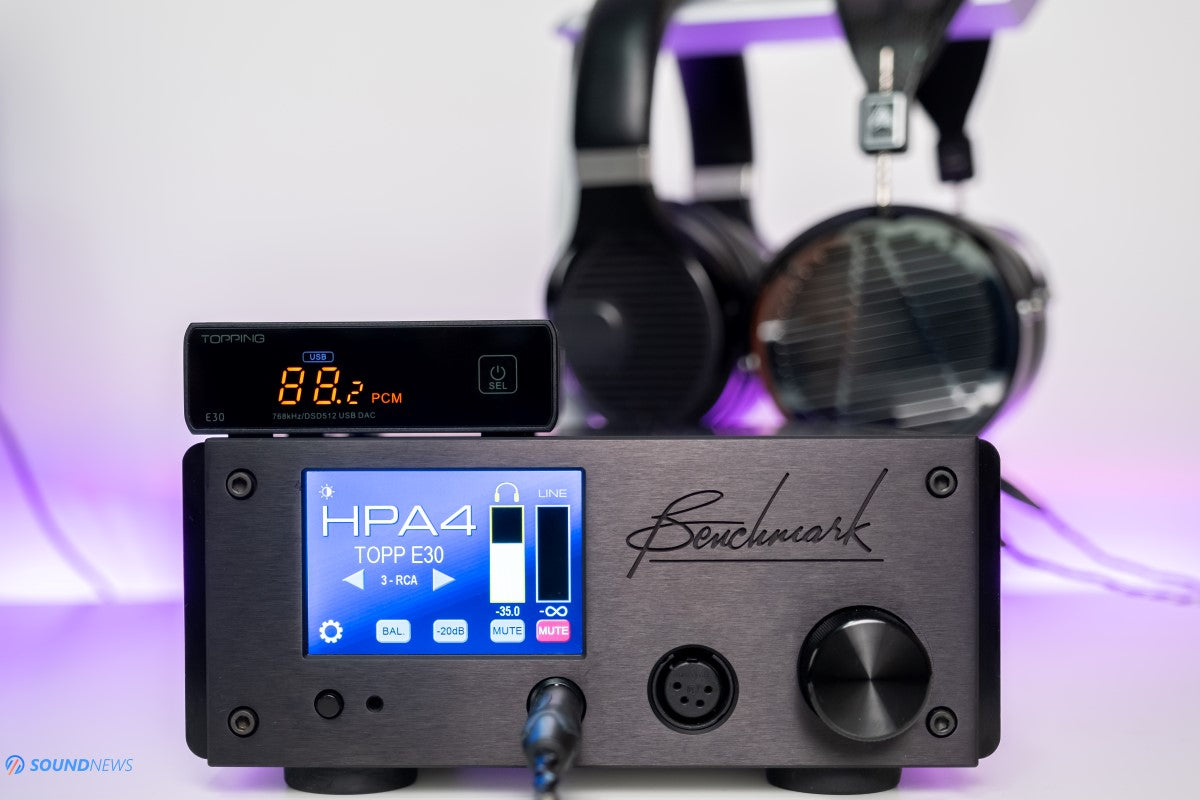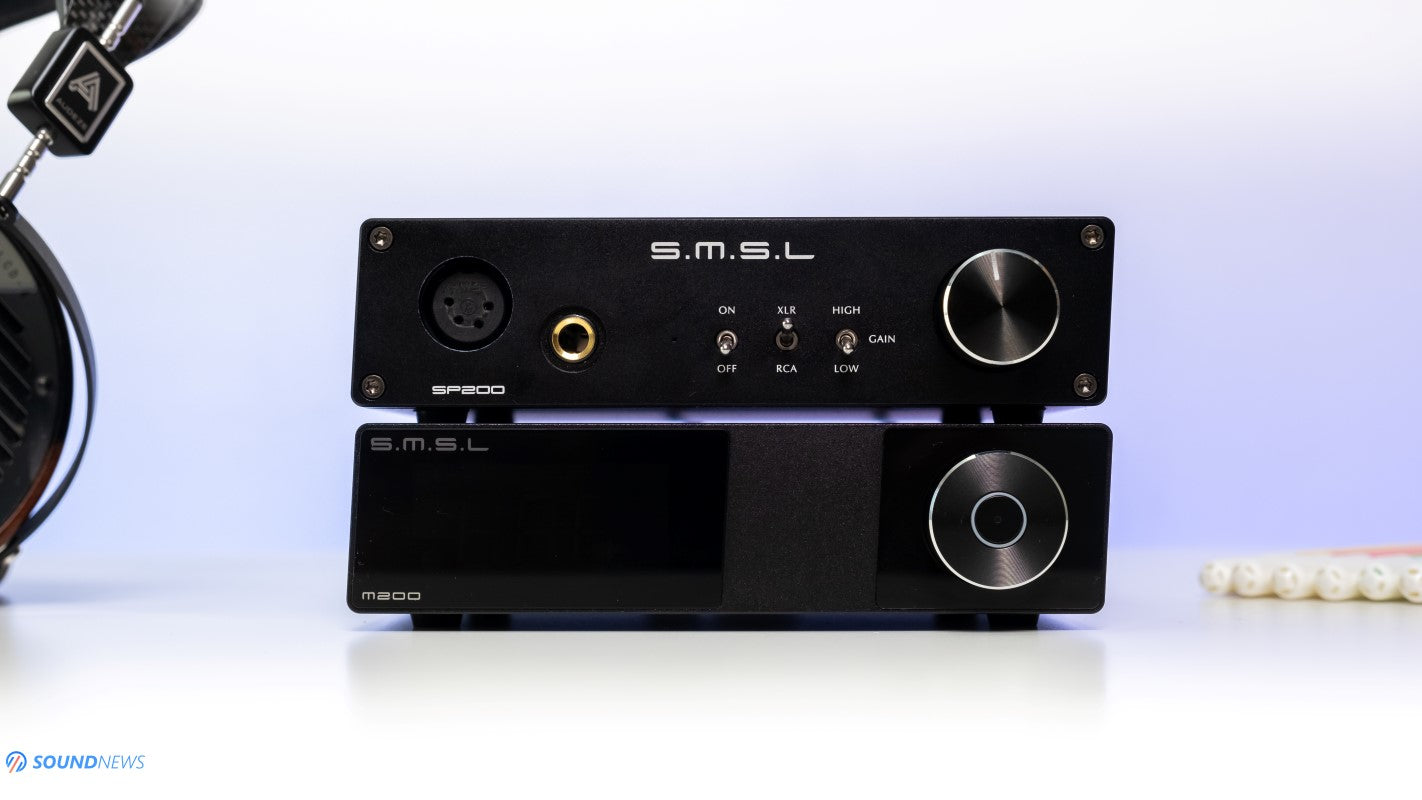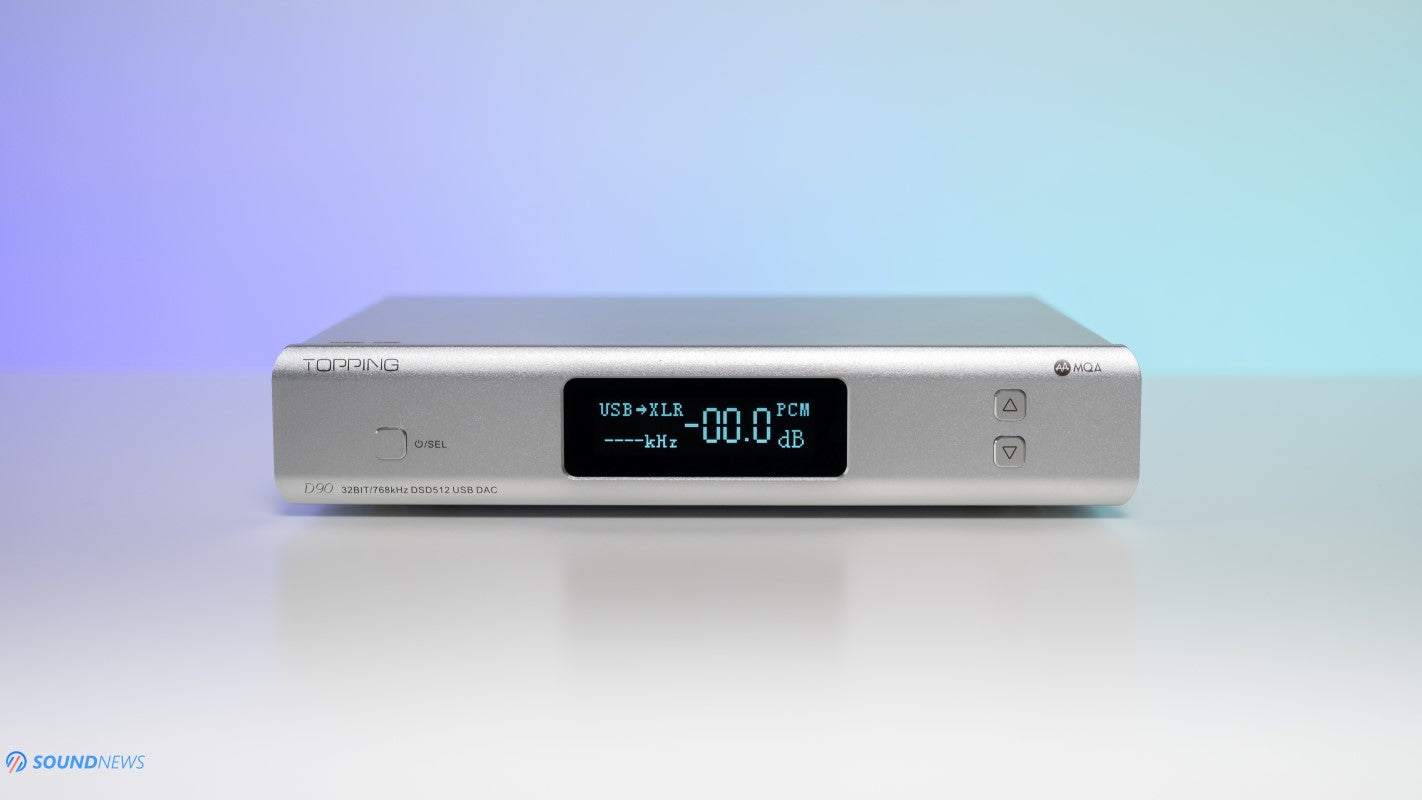
Topping D90 MQA Review – Majestic, Quick, Accurate
This review is posted here in partnership with Soundnews.net. It was originally written and published by Sandu Vitalie of Soundnews.net on May 16, 2020.
When my Topping D90 review went live and dropped here, it literally dropped like a bomb, our bandwidth was barely keeping-up, servers were barely holding together, I never expected having so many readers. To this day, it was read more than 60.000 times, it is still my most read and commented review and I want to thank you all for stopping by and leaving a word or two, I truly appreciate it and it means a lot to me.
Topping is such a secretive audio company, even with press and music aficionados like myself, they will never spill the beans of what is coming next. Press Releases? Hah! Be serious, never happened with Topping, but I hope they are learning. I’ve learned about the D90 development by mistake, same happened with D50s, but newest devices like E30 and D90 MQA were hidden from the eyes and ears of audiophile media. Immediately after D90 was released to the public, people requested one feature that would need a redesign of the PCB, a total upgrade of the USB interface and some few additional lines of code in the FPGA just to incorporate a full-blown MQA decoder. Living in days like these, it doesn’t come as a surprise that most of us are enjoying music directly from the likes of Tidal, Spotify, Deezer, Qobuz, Apple Music and so on. I will be honest with you, I have terabytes of lossless music stored on hard drives, but it is so easily just opening that Tidal Hi-Fi app on my PC, smartphone, TV and tablet, search for a favorite song, lean back, have a nice drink and enjoy some quality time. Convenience slowly but surely is paving its way in the Hi-Fi world and those increasingly profits year by year of the streaming services are proving that.
You will be probably rising an eyebrow right now; I know that it feels weird having a review for the Topping D90 and then coming with a D90 MQA review afterwards, but there is still a difference between them, even by completely ignoring and not listening to MQA files (more about that really soon). This in-depth review will not feel like a copy / paste and I wouldn’t use the same words, it doesn’t represent me. So, let’s move on and unbox this silver surfer.

Unboxing & Package Contents
- Double boxed? Yep.
- Extra foam for protection? A lot of that.
- An impressively detailed user manual with actual measurements of the RMS levels, of the digital filters, THD plus noise ratio, IMD ratio, FFT spectrum and others? Yep, a lot of that too. Big respect for including all those and I hope that other manufacturers will include measurements too in their manuals.
- Zero snake oil, zero audiophile buzz-words with real tech specs? Thanks Odin! There’s nothing of that in here.
As with the rest of the Topping DACs, it is coming with an USB type-B cable, with a Bluetooth antenna that also works as a signal booster, with a warranty card and with a power cable. There is a remote control as well, made out of matte plastic and rubberized buttons – decent quality considering the price of this unit.

Design & Build Quality
If you checked my former DX7 Pro and D90 review, you would know that I really liked the form factor and the build quality of those and D90 MQA is absolutely the same in this regard. It has a small footprint, so it can be easily integrated into tight spaces as office desks or in headphone setups. I like that the case and the front plate are rounded and pleasant to the touch. I like that those 3 buttons on the front are not sticking out too much, that OLED screen is perfectly aligned too, so no more OCD for me as it was the case with other units. D90 MQA is quite a looker, it has a really simple, yet elegant look.
D90 MQA has a lot of small details that often will differentiate a great product from a good product. For example, the MQA logo is laser-engraved on the case, my $3K Matrix Element X has a cheap sticker with an MQA logo as a point of reference. Topping carved four round spaces underneath it, so the rubber feet would sit in there without moving an inch while I’m re-arranging it on the table, I’m quite annoyed when rubber feet are leaving a trail of glue on expensive audio gear. Hiding all the screws on the back plate made it look classy and handsome. La pièce de résistance is definitely the uni-body case which has a simple front and back-plate attached to it, it really looks expensive and nicely put together.
Topping is offering two color options for it, in black or silver, I received it in silver. At first, I thought that I might not like that option, but it looks exactly like the case of Element X which I like quite a lot, it’s more like a matte silver, unlike the older D30 that had boring raw anodized aluminum.
At about 1.4 Kg it’s neither light, nor too heavy, but lifting it up and holding it gives a sense of a well-engineered and well-made product. From all the Chinese DAC manufacturers I have tested of late, I think Topping has definitely one of the best looks and form factor.
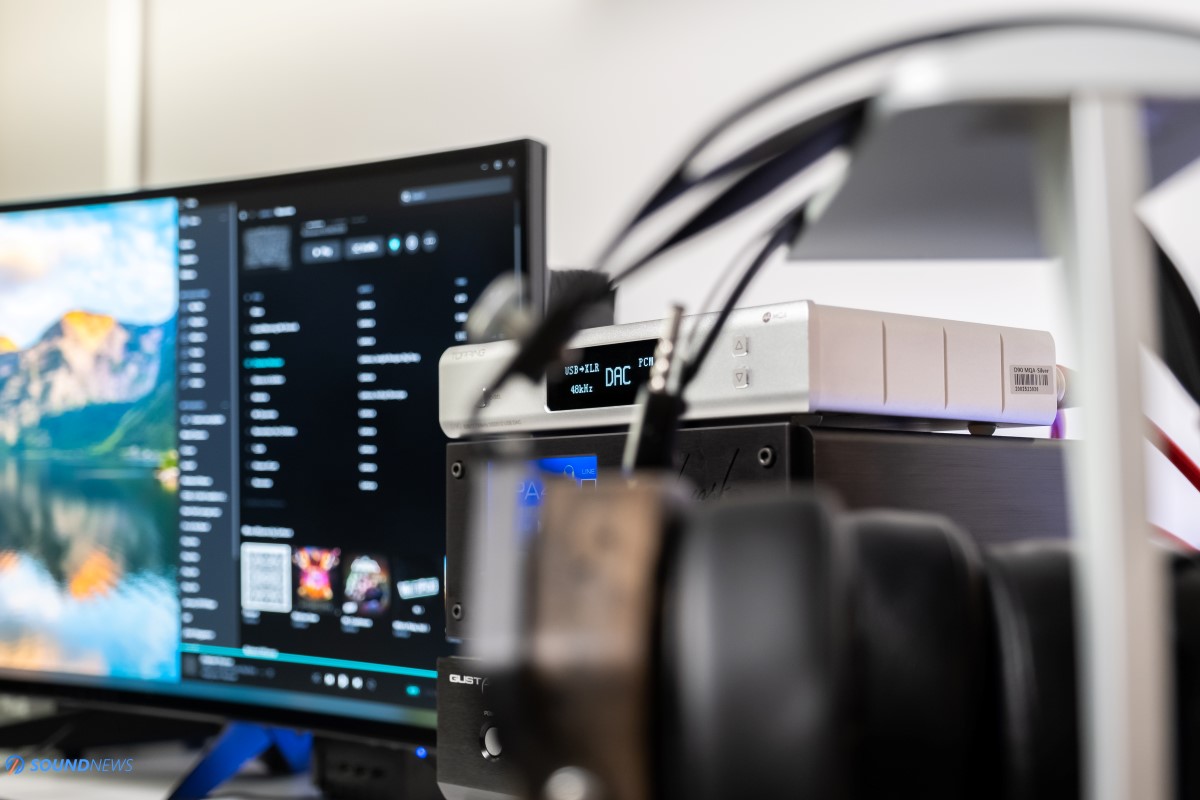
Controls & Connectivity
On the front panel you’ll find only 3 buttons, the first on the left will power it On and a longer press will put it into the stand-by mode, once the unit is working a short press will swap the digital input. On the right you have up and down buttons that will change options in the menu, or the volume setting if the preamp mode is engaged. In the middle there is a nice and bright monochrome OLED screen that will show a lot of important stuff as the selected input, output, the working mode (DAC or DAC + Pre mode), the sample rate, PCM of DSD data stream and the volume level if the preamp mode is engaged.
On the back all the nicer digital inputs are present as: USB, I2S, Optical, Coaxial, AES, there is a Bluetooth antenna socket too. Being a fully balanced DAC, it offers a pair of XLR and RCA outputs. Both are volume controllable or fixed, depending on the settings and you can even disable a pair of analogue outputs if you want. Its feature set is simply amazing.

Tech Inside D90 MQA
Topping used all their knowledge, refinement and polish in the digital domain to release their top-of-the-line D90 MQA DAC and preamp. They dropped the headphone output so that the signal path would be shorter and cleaner.
They used the best commercial DAC chip available today, so obviously the star of the show is that huge 128 pin, current driven, quad-channel AK4499 DAC chip of Asahi Kasei. It is their best so far and part of premium switched resistor DAC chips. AK4499 currently has the biggest die size of all DAC chips on the market and consumes a lot of power in the process. It is also incorporating the best Velvet Sound Technology that will reconstruct the clarity of the low-level signals and will lower the distortion for a more faithful re-creation of the music. Topping used a single DAC chip, but since it is a quad-channel one, a single one is enough for a full balanced signal, they even paralleled 2 outputs into one channel to squeeze better performance out of it.
Asahi Kasei recommends using they own low noise S/PDIF receiver with their converters, so it was natural using the AK4118 that takes care of all digital inputs except for I2S and USB.
Topping is using a very advanced Altera Max II FPGA that together with two Accusilicon AS318 femtosecond clocks will extract the best performance out of the AK4499. It is important to know that the Altera FPGA is infused with Topping own code so obviously the same hardware with different software code can sound very different, hence the substantial difference in sound quality between various DACs with the same components.
For current to voltage conversion, 4 high-performance OPA1612 from Texas Instruments were used, followed by 3 LME49720 op-amps and with some 0.1% precision resistors.
As for the power supply, Topping went with an encapsulated toroidal transformer, followed by 6 independent voltage regulators and by 7 big electrolytic high-grade caps (Nichicon FW series) that were specially designed for audio components.
For a good Bluetooth codec support and stable connection, they went with the highest performance CSR8675 BT receiver from Qualcomm, that currently supports all the best codecs as AAC, SBC, AptX, AptX-LL, AptX-HD and LDAC. Bluetooth version 5.0 and that wireless booster (antenna) will make sure to play all your tunes even with two concrete walls between the source and the D90 MQA.
The star of the show is obviously that full-blown MQA decoder incorporated what works only via the USB input. D90 MQA can fully unfold the MQA files stored on your PC or streamed directly via Hi-Fi streaming services as Tidal for example.
Another major improvement was utilizing the newest and the highest performance XMOS interface that was developed to date, the XU-216. Simply put, this interface has double the processing power (2000 MIPS) of XU-208 that sits in the regular D90, it has also 4 times the RAM size of second-generation XU-208 and 8 times the RAM capacity of first-generation X-U8. If this reads like some gibberish non-sense, in simpler words D90 MQA has the potential of sounding better than the regular D90 on the USB input, especially with Hi-Res PCM and DSD material that requires more RAM and much higher processing power.
If you thought that a full-MQA decoder is the only difference between the two units, you were mistaken. D90 MQA seems to have the latest and the newest technology, especially the digital side seems to be using the latest developments in the audio industry.

Tips & Tricks
Before going deep into its performance, in typical SoundNews fashion, I have some very important tips to share with you that will help you achieve the best sound quality out of D90 MQA.
You can control the D90 MQA via the its buttons on the face plate, with the included remote few additional settings will be unlocked – this is why I recommend using the remote as much as possible and there is also a hidden menu which Topping buried deep into the user manual. To access it turn it Off completely (with the switch on the back), press and hold the menu/stand-by button on the front panel and while you keep pressing it turn the switch on the back to On position and an advanced menu will appear, from which some settings are quite mandatory:
- If you are using the D90 MQA in a headphone setup or if you have already a dedicated preamp in a speaker setup, I strongly recommend disabling the preamp mode, the setting no. 3 will let you choose between DAC mode (completely disabled the digital volume and keeping it fixed at full power - 4V on XLR and 2V on RCA) or PRE mode.
- If you use just a single analog output, RCA or XLR and don’t use the second one, I recommend disabling the second output – it is setting no.4
- If you don’t plan on using the Bluetooth input, or maybe you’ll use it casually from time to time, I recommend disabling the BT module – it is the setting no.5 from that menu
- Lastly, if you check the user manual carefully, the FFT Spectrum will show the measured difference of those 6 digital filters, out of those Filter 3 and Filter 4 have the lowest ringing past 20 kHz, this is why I recommend using filter no.3 for a smoother top end or filter no.4 for more treble presence past 24 kHz.
If you plan on using the D90 or D90 MQA in a speaker setup as a DAC + Pre, just skip the first recommendation. By following these tips, you will be squeezing the last drop of performance out of it.
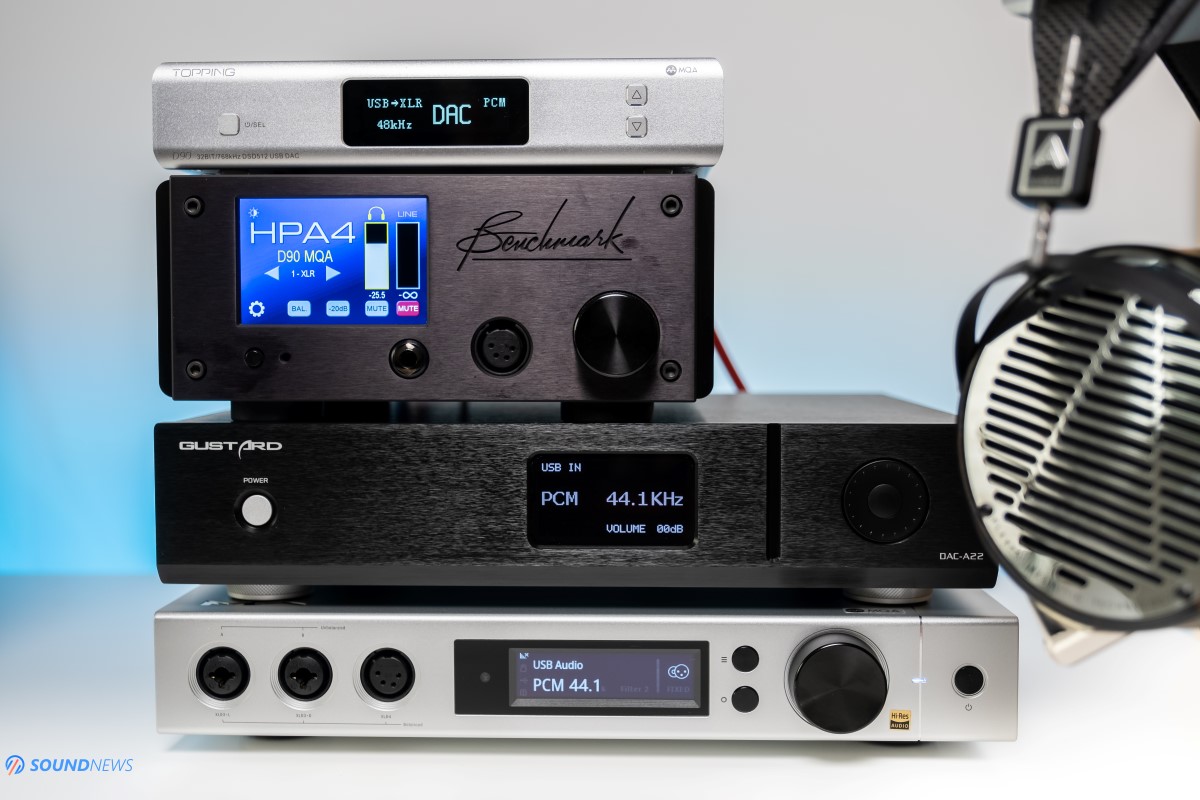
Test Equipment
I’m still feeling a bit guilty that D90 was tested just barely in a speaker setup so this time around I will be spending more time with it as a dedicated DAC and separately as a DAC + Pre combo. In a headphone setup, I wanted to have the best of it, so I went balanced to the Benchmark HPA4 and for fun I also tested it with Flux Lab Acoustics FCN-10 via the RCA input.
In a speaker setup, D90 MQA worked first as a DAC only device, followed by the HPA4 as a Pre, by the Keces S125 as a power amp, powering the Buchardt S400 loudspeakers. Lastly, I removed the HPA4 from the acoustic chain and let it work as a DAC + Pre combo.
OK everybody, I’m ready to press play, lean back and enjoy some quality time with it.
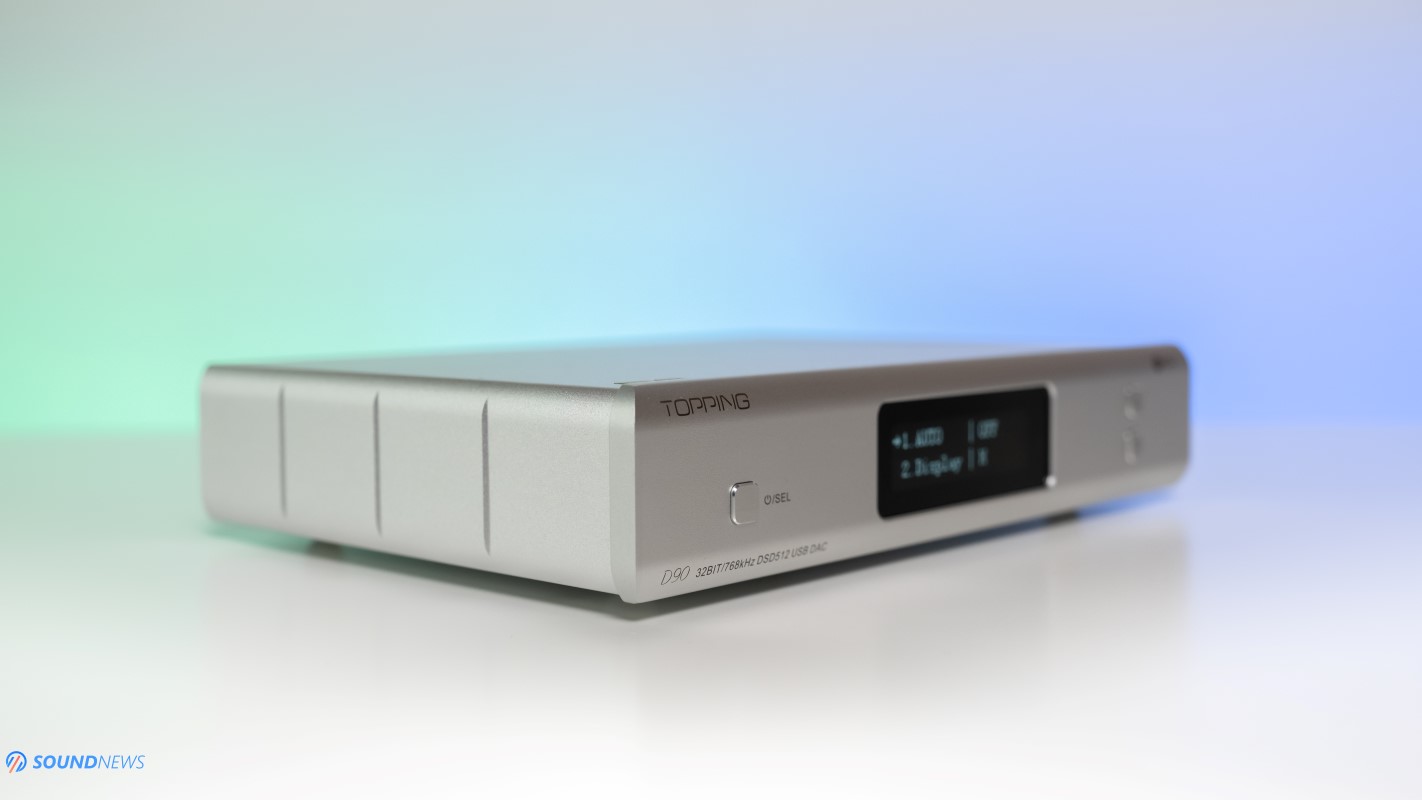
Sound Performance
I. Preliminary Impressions, Tonality and Timbre
Some grumpy audiophiles are still considering that you cannot have high-end sonics or even decent performance out of sources that costs less than $2K, I know few people that think this way, others simply swear that in the sub-$1K price category, there are only entry-level to mid-fi digital sources at best. I am judging an audio component by its performance first and then by its price and only after that I’m evaluating it if is worth the asking price or not. If I you would be a grumpy audiophile, would listen to D90 MQA, would try all its features and its user-friendly interface, then I would probably say that it costs around ~$3K. D90 MQA is without a doubt an impressive DAC even at double its price. I say it, because I am testing quite a lot a DACs and as time passes by, I’m feeling that the difference between expensive and affordable DACs is shrinking at a very rapid rate. I am very glad this happens, as not everybody can afford multi-thousand systems. D90 MQA is really an eye opener when it comes to simple things as user interface, ease of use, features and most importantly sound quality. As a whole, it sounds very extended in the FR, it impressed the most with its layered, punchy and deep diving bass response, with its naturalness and soul-grabbing midrange, with that open wide sound that brings more air in the room, everything it is still in there. Treble is quite detailed too and you can hear every shimmer, any drum hit clearly and easily without stressing yourself too much. Sharpness is not its strongest point, D90 wants to impress more with everything else, very strong leading edges are not present as well and maybe it’s for the good. I am listening to it for the fourth day straight and I‘m still not having any listening fatigue. If you work while listening to music, D90 MQA offers a smooth and effortless ride.
If you are coming from any Topping DAC to this unit, the gain in performance will be simply massive, I am hearing a bigger sonic improvement between D70 ($500) to D90 MQA ($800), than from E30 ($130) to D70 ($500). All the past sources from Topping were engineered great but lacked in few key areas, so when it came to raw slam and punch, they never really did that with authority and the stage size while being good it was never great. D90 MQA feels like a big departure from all their products and even some of the costlier units coming from Europe and USA didn’t impress me as much. In the end, it all comes to tonal balance and this is where D90 MQA hit the nail in the head, preserving the technical aspects as much as possible and offering sweet harmonics for the listener.

II. Using D90 MQA is a speaker-based setup
Generally speaking, when I’m looking at that op-amp based output stage plus two final output transistors – I’m not quite impressed. I’ve seen much bigger, beefier and heavier output stages and yet I don’t know how, as a DAC only device D90 MQA is having a really nice kick in the chest, a nice transient response, it got speed, impact, it knows how to land a punch, it knows how to increase those dynamics and raise the hair on my hands.
When it worked as a DAC + Preamp (PRE mode engaged) in my system, there was a degradation in sound compared to the Benchmark HPA4 (a $3K dedicated preamp), control was worse, transients lowered their speed and that super wide and airy stage was slowly shrinking in size. In all fairness, D90 MQA doesn’t really have a true preamp inside, it is what I am calling a digital preamp where it simply attenuates that 2V or 4V signal. It will not outperform a dedicated preamp; it will not outperform the preamp inside the Gustard A22 for example and its preamp section will probably not live to the legendary status of its DAC section. It is OK to good as a preamp, but with some powered speakers there isn’t a point of using a better one.
While listening to Lindsey Stirling – Crystallize while the overall performance was really enjoyable, the stage was not as holographic and was not enveloping my whole body as it would happen with HPA4 in the chain. The heft of every note felt thin and hollow inside, the kick was missing some force, like the air was not moved so easily in the room. S400 started sounding mellower and smoother as how I know them to be. The upper treble felt less crisp and less textured, somehow rounding it for a smoother top-end. All in all, I was not disappointed that much and considering the price point of this unit, the preamp section is decent enough, just don’t expect it outperforming dedicated preamps with powerful output stages. So far, this is the only area where I consider it having less than immaculate performance.
As a DAC only device in the speaker setup, leaving the preamp duty to the Benchmark HPA4, everything came back to normal and sincerely between D90 MQA and Matrix Element X I’m hard pressed to choose one or the other, but more about that in the comparison that will follow.

III. Background Noise
I cherish that Benchmark HPA4 as it helped me so many times in discovering all the good stuff a digital source wants to show-off and all the bad things a source will try to hide away. Background noise and detail retrieval are hardest things to spot and usually higher quality equipment and music is needed for that to happen.
This will be a shorter chapter as there is no other way of saying it, when I connected some sensitive IEMs to the HPA4, put the volume higher that went past my comfortable listening level, I didn’t hear any artifacts, no buzzes, no noises, not a trace of nasty gremlins playing in the background, nothing like that. Simply put, the background was really quiet, it was pitch black and no matter the volume level or the driver that played that music, I knew I can always rely on its clean performance. I had the same experience in the speaker setup, I went really close to the speakers and there I heard it loud and clear: it was the sound of silence.

IV. Transient Response
This is one of my favorite things to write about and since listening to Antonio Vivaldi will not yield any conclusive results, naturally some harder slamming music will be needed.
I engaged The Prodigy – Light Up The Sky that I streamed directly from Tidal in MQA format, I put Audeze LCD-4 on my head and that was the moment when my hands started flying in the air, toe tapping like I had double bass pedals under my feet, a massive spike of energy simply hit me up and stomped my body. This is one of the strongest points of D90 MQA, it simply knows how to impress with that perfect pace, rhythm and timing. It hits fast and it hits hard, I simply cannot stay still with this kind of performance. If you are into any kind of faster kicking music and you are seaking for a smile inducing performance, then this is a really good option.
This week I re-listened to Implant Pentru Refuz – SubRadar probably more than 5 times already, it simply keeps calling my name, I’m thinking about this record every hour or so, it keeps reminding me that blood is thicker than water, never forget we are all Earthlings. The track Rezonanță, combines local folk elements with modern rap and hardcore and the end result is a blend of dopamine, headbanging and fast solos. While the mastering is not perfect, the message was delivered, it was able to create music, it moved me and I wanted to be part of it. I loved every second of this album while listening to it on D90 MQA.
Listening to Black or White by Michael Jackson, when everything is coming together at 0:57 mark, I simply felt an enormous positive energy flowing in my veins. D90 MQA simply moved large amounts of air so easily, every hit was felt distinct and very real.
As far as D/S DACs go that are based on any AKM chipset, D90 MQA together with D90 and Gustard A22 offered the fastest kick, the hardest slam, it instantly pushed high those dynamics, it was simply a roller-coaster, it felt like having a dissociative identity disorder, depending on track it would simply switch between being a relaxed n’ cool guy to an aggressive puncher.

V. Resolution & Transparency
Lettuce just released their newest album called Resonate that is actually a follow-up to their excellent Elevate album released last year. The mastering quality of this record is top notch and you are a fan of modern jazz and funk, I strongly recommend giving it a try. Even from the first track called simply Blaze, I was simply taken away by how many instruments are surrounding me, I simply closed my eyes and could see every single one sharply, defined and textured. They use so many of them, even the treble response is so crowded with snares, drums, cymbal crashes, bells and tambourines that it can be overwhelming at first, because you don’t really know where you should turn your head as you’re simply bombarded with sounds from every angle. The most interesting aspect is that in a very complex track like this, I was able to discern and follow every instrument I wanted quite easily. My personal Matrix Element X has a clearer leading edge, but at the cost of a smaller and shallower stage that is less impressive in this particular song. No matter the song I would listen to, D90 MQA always had a great see-through transparency that made me appreciate the smallest details in a track, see all the bad and good in a track. While the resolution is on a very high level, the leading edge or the contour of all notes is not very sharp, making it free of any digitus, grain and over-sharpness. Detail doesn’t feel forced, nor does it scream for your attention, it’s always there, if you want to look for it, is entirely up to you.

VI. Soundstage & Depth
When I tested the regular D90, it already sounded as the airiest and widest sounding AKM based DAC. Depth was excellent and the pin point location of all notes was very exact and precise. D90 MQA is really the same and excels at live recordings, throwing a big picture in front of the listener and disentangling even the most crowded and up-front music there is. As was the case of the transient response, D90 MQA really excels in this area and feels at home with that open and airy presentation.
Norah Jones just released 3 new singles, I started with How I Weep and it’s an MQA track, whoof, it feels so exciting, I’m already feeling horny. I will throw a wild guess, that her newest album is just around the corner. Norah always had cozy and relaxed tracks that would put a big accent on the voice, that would be always perfectly centered and everything else would be positioned far away from her, making her the centerpiece and the shining star. I always liked that, because I have her voice super defined as a separate entity and everything else felt like accessories around a beautiful voice. Listening to Seventeen by Sharon Van Etten feat. Norah Jones I simply felt the performance going deep into my soul, I felt a massive relaxation of the body and mind, I felt heavier too, it was such a deep performance that I could easily look into and be surrounded by it. This recording is neither too wide, nor too cozy or close-in, yet everything feels so spread around me, so perfectly positioned at their right places, decaying naturally and going back into their own shelves. I could definitely say that imaging was as good as it can be and so was the stage size. It’s never really up-close and personal, that battle would always be in an open field. Those final touches spread in the background added just a tiny amount of zing and presence up top, like good seasoning for a nice meal. An amazing performance that was perfectly preserved on the D90 MQA.
If soundstage is what are you chasing for in an affordable DAC, D90 MQA and D90 are probably the best variants right now that will not limit the stage size in any way.

VII. The MQA Experience
D90 MQA as its name suggests is coming with a full-blown MQA decoder that will unfold the original MQA file and decode it natively.
I am personally streaming music a lot more often than listening to it from the local hard drive. Why? Convenience, I can access all my tunes from any browser on any smart device. When it comes to high-resolution MQA streaming, there are only 3 services that are offering such files: Tidal, Qobuz and very recently Amazon Music. Once you have a subscription to any of these 3, you’ll have access to a wide variety of MQA files that are released on a daily basis. These files can have up to 24-bit and 192 kHz in resolution with the last bits of information being stored in a lossy format, so in reality a 24-bit 192 kHz MQA file can have almost the same file size as a 16-bit 44.1 kHz WAV file. The lesson is simple: an MQA file still has additional information and bits of resolution compared to a lossless 16-bit file, so it is normal that an MQA record will sound better than a non-MQA variant of the same album.
Now, here is the clever part, to playback that MQA content you have two options: software decoding how for example Tidal desktop app is offering and hardware decoding - but for that you will need a full MQA decoder and luckily D90 MQA has one inside. Once you play those files, instead of showing PCM or DSD data streams of that OLED screen, MQA lettering will appear.
Going back and forth between software and hardware decoding, there is a clear difference that hardware decoding sounds simply better. The same can be said about the same album in regular 16-bit lossless format and in MQA, later one will clearly sound better.
So, what was the difference? I had the same feelings when I compared a well mastered 24-bit Hi-Res record to the same record in 16-bit. The frequency extremes at both ends are just richer in information and a lot more defined, there is a bit more sub-bass, a clearer treble performance and most importantly (at least for me it is) music sounds more liquid, smoother in a way, more life-like and less digital once it is played in MQA format. If you are streaming a lot of music as I do, D90 MQA is a worthy, or should I say must-have upgrade over the regular D90 or over any other Topping device. I am an avid Tidal Hi-Fi user, I use it daily and it helps me at discovering new music, at making custom playlists, it reminds me if my favorite bands have new releases, it is very convenient to use.

VIII. Frequency Response
If you are new around here, you should know about my pure obsession of a wide and extended frequency response. It is still not everything a DAC can show to you, how 90% of the audio press around the world thinks, not even close, there are still many other important things in a digital source. There is a reason I’m on chapter VIII, right?
As it was the case of D90, the newest D90 MQA plays that sub-bass with its chin up, chest in front and it feels proud about it too. Jokes apart, D90 MQA is a champ when it comes to sub-bass. There are only about 5 DACs that I tested at my place that had an amazing low-end, with a heavy rumble down there, that can maintain it in a heavy electronic track and then decay it naturally at the right time. I will not mention all those sources, but I will mention that D90 MQA and the Gustard A22 offered among the weightiest low-end from the delta-sigma DAC kingdom.
When I’m listening to something like The Prodigy, or Infected Mushroom on a R2R DAC, it’s always a hit or miss situation, some of them with be snappy, offering great bass notes and others would simply ruin my listening experience. With D/S DACs some of them are just not having the extension that I am craving for; in just a minute I would know if it is limited or not down there. D90 MQA is not limited at all and on the contrary makes it defined, full-bodied, it takes the spotlight most of the time. It is not a bass heavy digital source by any means, but a really good one when it comes to bass.
Midrange…felt defined and textured most of the time. I was really carried away by the voices of Norah, Lindsey and Sharon, I felt them having a natural pitch, a life-like vibration and I felt their voices slowly disappearing in a black void. AKM based DACs always shined in this department. I will slightly rephrase my statement: AKM based DACs mostly shined in the midrange department and were just good at everything else, but D90 MQA together with D90 and with that Gustard A22 that I’m still mentioning here and there, are completely different offering not only midrange presence and naturalness but also frequency extremes, at both ends. Midrange together with that intoxicating bass, were the nicest when it comes to frequency response.
Treble is quite extended, you can hear it shimmering, you can clearly hear those bells ringing just right, cymbals crashes have a nice pitch, snare drums have quite a life-like texture as well. The only thing that differentiate it from a top-of-the-line DAC is the outline and the leading edge of the treble is not super defined and sharp. Again, you hear the shimmer, but it will never bother you, you hear the cymbals crashing on your, yet not a sign of any kind of brightness or digitus. It can be a double-edged sword for some. Some music would possibly need a bit more treble presence and some music will need less sharpness and texture up-top and D90 MQA is offering exactly that. Extension up to the highest octaves is there, detail is also there, only the sharpness is not up there with the best.

IX. Wireless Performance
I upgraded to a smartphone that has all the latest Bluetooth codecs, it natively supports LDAC and AptX-HD data streams, it is also Bluetooth 5.0 enabled, so I will be squeezing the best D90 MQA is capable of via Bluetooth.
How to connect to it? Well, it’s quite simple. Press the multi-function button until the BT lettering will appear on its screen, enable BT on your phone and search for the D90, connect to it and voila! My smartphone is showing a stable LDAC connection, so I will be testing the best it could offer, as LDAC is currently the best Bluetooth codec that supports even 24-bit files at up to 990 kb/sec.
The coolest part is that I have Tidal Hi-Fi app on my phone, so I can stream all that music directly to it. I connected it to the speaker setup and I streamed everything I wanted directly to it. To my surprise, the difference is really small or close to zero between listening to it via USB or via Bluetooth to the same 16-bit lossless file. Since it was sitting in the middle of our home, I tried as hard as I could disconnecting my phone from it, I walked in all the rooms but it never dropped a beat and it worked flawlessly. Only when I moved to the balcony, about 3 concrete walls and about 15 meters away from it, I started losing that connection with pops and cracks coming out of speakers. In an open space, I tried as hard as I could, but the signal was always super strong and steady. D90 MQA can work really well even with Bluetooth sources, just make sure to stream lossless content for a better sound quality.
X. Comparisons
Some of you requested a comparison with the Gustard A22 and some with my Matrix Audio Element X so here it goes.
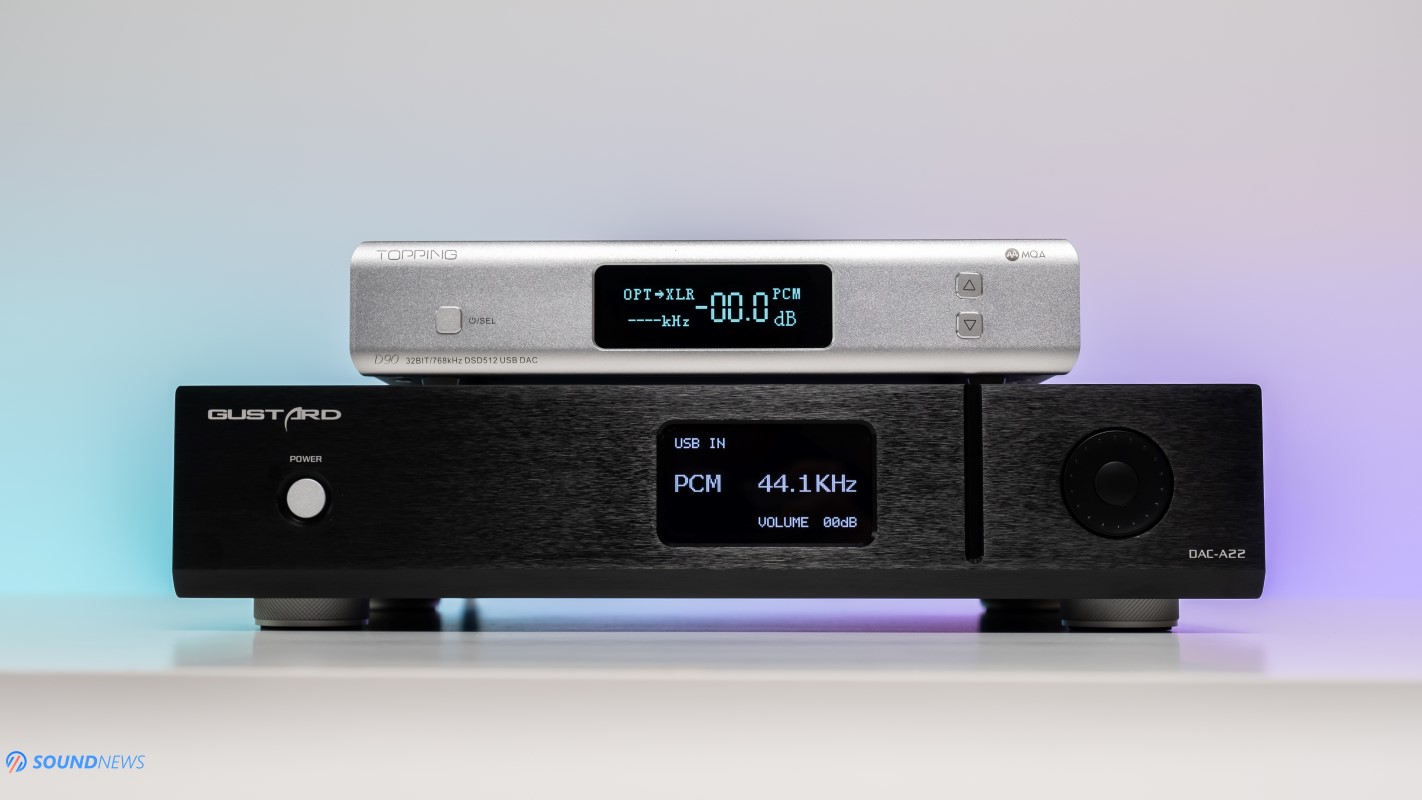
A. Topping D90 MQA ($799) VS Gustard A22 ($1099)
D90 MQA has quite a lot in common with the A22, they both use the same DAC chips, S/PDIF chips and they have the same Accusilicon crystal clocks. The power supply and filtering are much beefier on the A22, it uses discrete components in the I/V stage, 4 output transistors instead of two, discrete components instead of op-amps and it is offering up to 6V of power on the XLR instead of 4V on D90 MQA. Topping unit has a higher performance USB chipset (XU-216) and obviously a full MQA decoder in place.
Before comparing them, I needed to volume match both units since A22 is offering a much hotter signal. MiniDSP EARS recorded a difference of 3.5 dB which is quite a lot and without any matching I could easily prefer the louder one.
As DAC only devices, both are having the same full-bodied tonality, an emphasis on the bass and midrange area most of the time. Both sounded big and open wide, I could easily follow any note I wanted in a crowded track. The biggest difference was felt in the treble region, where A22 would offer an extended top-end, there would be more shimmer, a bit more zing and slightly more information could be picked up as well. As a direct result A22 sounded a bit more complete, especially the frequency response felt wider and more extended.
By comparison, D90 MQA felt a tad smoother sounding, more relaxed in the long run. It was less fatiguing but felt incomplete by comparison. D90 MQA felt mellower and lacked the nerve and the boldness of A22 that just offered higher dynamics. Another difference was felt in pin point imaging, where A22 would show an improved accuracy. I could easily detect where all sounds are coming from, the leading edge (contour) was also a bit more defined on it, A22 was a bit more precise and more defined as well. In terms of slam and transient response, both were absolutely exceptional, offering an engaging and mood lifting presentation.
As DAC + Preamp devices in a speaker setup, even from the first seconds A22 simply took the lead. Everything was more defined, clearer, it offered a much better control over the speakers, stage was a tad wider as well, everything became big, holographic and very 3D. D90 sounded pretty good too, but couldn’t compete as a preamp due to its weaker output stage.
Bottom line is that as a DAC only device, I could easily live with one or the other, as the difference was not that big with small differences in tonality. However, as a DAC + Preamp device, A22 was a different animal entirely and would be my top recommendation in a speaker setup.

B. Topping D90 MQA ($799) VS Matrix Audio Element X ($2999)
Element X and D90 MQA share the same powerful USB chipset and MQA decoder, Element X uses ESS9038 PRO DAC chip instead of AK4499, it uses probably the best production toroidal transformer (Noratel XS series), it uses slightly better femtosecond clocks from Crystek. Element X is also a lot more advanced in terms of features, since it includes a full-blown streamer via Wi-Fi, controllable via an app, it includes a music player by connecting external flash/HDD drives to it, it includes a balanced headphone amplifier, hence the huge price difference.
I again volume matched them with the MiniDSP EARS, it recorded a stronger signal of about 1 dB in favor of Element X.
As DAC only devices, I listened to a lot more music, because both units share a lot of traits together. Element X is quite an unusual ESS Sabre based DAC, because it sounds full-bodied, has an impressive midrange and probably the best sub-bass I ever heard in a digital source. Element X was a bit more extended up-top, but not as much as the Gustard A22, it also felt very complete in the frequency response but without offering any listening fatigue. Element X had the fastest transient response of them all. If I am listening from its internal player or via its streamer, Element X again takes the lead as the best digital source, skipping all the issues of the USB connection, it simply offered more resolution and in the same time felt more liquid, it felt like real music and not like a decoder.
Moving back to USB, D90 MQA was impressively close to the Matrix unit, losing just a tad in terms of speed, slam, treble information and detail retrieval. It was surprised that in few occasions D90 MQA felt as wider sounding and deeper as well, the difference would be very small though.
When I moved them both in the speaker setup, connected directly to the Keces S125 power amp, Element X took the lead and offered a bigger picture, a better grip over the speaker drivers, it was faster and harder slamming too and still preserving its super clean nature. Element X was quite good as a preamp, but it would not outperform the Gustard A22 in a speaker setup.
D90 MQA came last as a preamp, I sincerely expected that, it is not bad by any means, but simply cannot compete with dedicated preamps with powerful output stages.
As a DAC only device, it was more of a flavor thing, M90 MQA was really close to both A22 and Element X and I could easier live with any of these units. Considering their prices thought, D90 MQA is simply the undisputed champion and cannot be beaten when it comes to value.

Conclusion
Topping took their best DAC, they upgraded its USB interface with the latest XMOS chip, they added a full MQA decoder and charged only an extra $100 for that. The sneaky Matrix Audio did absolutely the same with their X-Sabre Pro when they upgraded it with MQA capabilities, but they charged an extra $200 for that! How come? Neo would not approve that.
When it comes to affordable and overachieving DACs that look great, have a nice design and build quality, that are not skipping on user interface, being user friendly even with newcomers; Topping is currently number one, worldwide.
Topping D90 MQA feels like a love letter to music lovers and streaming heads around the world. At $799, Topping (again) raised the bar and proved that high-end sonics could be achieved even at less than $1000, grumpy audiophiles this one is for you. If you are a streaming nut as I am, there isn’t a better unit than this one. If you get one, I can’t wait hearing your thoughts and your experiences with it.
Topping D90 MQA was provided by Apos Audio, it can be purchased from their web-store (they offer free shipping in the USA, free 30-day returns in case you don’t like it, an extra 1 year of warranty and lowest price guarantee).
PROS:
- Beautiful and sleek looking device with a solid build quality
- Amazing depth, wide soundstage and very 3D sounding
- Linear frequency response and super extended on both ends
- Impressive levels of transparency and resolution
- High-precision pin-point imaging
- Excellent dynamics, pace, rhythm and timing for an AKM design
- Lacks any noise and distortion, black as night background
- Full-bodied, rich in tonality and very life-like sounding
- Unexpectedly good slam and impact
- Widest selection of digital inputs
- A full MQA decoder will improve your Tidal/Qobuz/Amazon Music listening experience
- The best value as of right now
CONS:
- The preamp section was not on the same level with its DAC section
ASSOCIATED EQUIPMENT:
- DACs: Topping D90 MQA, Gustard DAC-A22, Audio-GD R7 (2020 version), Matrix Audio Element X, Denafrips Venus, Flux Labs Acoustics FCN-10
- Headphone Amps: Benchmark HPA4, SparkoS Labs Aries, xDuoo TA-30
- Preamps: Benchmark HPA4
- Integrated Amps: Hegel H190, Keces E40
- Power Amp: Keces S125
- IEMs: FiiO FH7, FA9
- Full-sized headphones: Audeze LCD-4, Erzetich Phobos, Hifiman Arya, Quad ERA-1
- Loudspeakers: Buchardt S400, KEF LS50W
- Interconnects: QED Reference XLR (x2), Aune AL3 XLR
- Speaker cables: Kimber PR8, Audioquest Type4
- Power Cables: Isotek EVO3 Premier (x2)
- Balanced Isolation Power Conditioners: PLiXiR Elite BAC400, KECES BP-600


